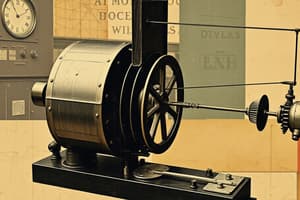Podcast
Questions and Answers
What does Hooke's Law state?
What does Hooke's Law state?
Hooke's Law states that the restoring force (F) is proportional to the displacement (s) from the equilibrium position and acts in the opposite direction: F = -ks.
Define elasticity in the context of material properties.
Define elasticity in the context of material properties.
Elasticity is the ability of a material to resist deformation and return to its original shape after the applied force is removed.
What is Simple Harmonic Motion (SHM)?
What is Simple Harmonic Motion (SHM)?
SHM is periodic motion where the acceleration is directly proportional and opposite to the displacement from the equilibrium position.
At zero displacement in SHM, what are the values of acceleration and velocity?
At zero displacement in SHM, what are the values of acceleration and velocity?
What happens to acceleration and velocity at maximum displacement in SHM?
What happens to acceleration and velocity at maximum displacement in SHM?
What two forms of energy interchange during Simple Harmonic Motion?
What two forms of energy interchange during Simple Harmonic Motion?
When is acceleration at its maximum during SHM?
When is acceleration at its maximum during SHM?
Name three examples of systems that exhibit Simple Harmonic Motion.
Name three examples of systems that exhibit Simple Harmonic Motion.
What role does the elastic constant (k) play in Hooke's Law?
What role does the elastic constant (k) play in Hooke's Law?
How is angular frequency denoted in the context of SHM?
How is angular frequency denoted in the context of SHM?
How is the amplitude calculated in simple harmonic motion (SHM)?
How is the amplitude calculated in simple harmonic motion (SHM)?
What is meant by frequency in the context of SHM?
What is meant by frequency in the context of SHM?
Which two laws are equalized to demonstrate the relationship between acceleration and displacement in SHM?
Which two laws are equalized to demonstrate the relationship between acceleration and displacement in SHM?
What will the motion sensor display when demonstrating simple harmonic motion?
What will the motion sensor display when demonstrating simple harmonic motion?
What does the period of a simple pendulum depend on?
What does the period of a simple pendulum depend on?
Why is the pendulum bob made to oscillate multiple times to find the periodic time?
Why is the pendulum bob made to oscillate multiple times to find the periodic time?
How does the period of a simple pendulum change with the length of the string?
How does the period of a simple pendulum change with the length of the string?
What is the relationship between the period squared (T^2) and the length of the pendulum?
What is the relationship between the period squared (T^2) and the length of the pendulum?
What is the formula for deriving the acceleration in SHM using the laws mentioned?
What is the formula for deriving the acceleration in SHM using the laws mentioned?
How can the acceleration due to gravity be calculated from the slope of a graph of length versus T^2?
How can the acceleration due to gravity be calculated from the slope of a graph of length versus T^2?
How does the stiffness of a spring influence its behavior under load according to Hooke's Law?
How does the stiffness of a spring influence its behavior under load according to Hooke's Law?
Describe the energy transformations that occur in Simple Harmonic Motion (SHM).
Describe the energy transformations that occur in Simple Harmonic Motion (SHM).
What is the significance of the negative sign in the equation of Hooke's Law?
What is the significance of the negative sign in the equation of Hooke's Law?
Explain the relationship between acceleration and displacement in SHM.
Explain the relationship between acceleration and displacement in SHM.
How does circular motion relate to the concept of angular frequency in SHM?
How does circular motion relate to the concept of angular frequency in SHM?
Explain how the amplitude is measured in simple harmonic motion.
Explain how the amplitude is measured in simple harmonic motion.
Describe the relationship between frequency and period in simple harmonic motion.
Describe the relationship between frequency and period in simple harmonic motion.
How does a pendulum demonstrate the principles of simple harmonic motion?
How does a pendulum demonstrate the principles of simple harmonic motion?
What does the slope of the T^2 versus length graph indicate in the context of pendulum motion?
What does the slope of the T^2 versus length graph indicate in the context of pendulum motion?
Discuss why using a motion sensor and data logger is beneficial for studying simple harmonic motion.
Discuss why using a motion sensor and data logger is beneficial for studying simple harmonic motion.
Flashcards are hidden until you start studying
Study Notes
Restoring Force and Hooke's Law
- Restoring force (F) is proportional to displacement (s) from equilibrium: F = −ks.
- Negative sign indicates restoring force acts in the direction opposite to displacement.
- Hooke's Law applies only within a material's elastic limit.
- Elasticity allows materials to resist deformation and return to original shape post-force removal.
- Elastic constant (k) connects force and displacement, measured in Newton per meter (N/m).
- Stiffness of a spring determines its compression under load.
Simple Harmonic Motion (SHM)
- SHM is periodic motion where acceleration is proportional and opposite to displacement from equilibrium: a ∝ −s.
- Proportionality constant between acceleration and displacement is ω² (angular frequency).
- In circular motion, ω represents angular velocity in rad/s.
Energy Relationships in SHM
- At zero displacement: acceleration is zero, velocity is maximum.
- At maximum displacement: acceleration is maximum, velocity is zero.
- Energy oscillates between kinetic and potential forms during SHM.
- At zero displacement: maximum kinetic energy, zero potential energy.
- At maximum displacement: maximum potential energy, zero kinetic energy.
- Common examples of SHM include mass on a spring, simple pendulums, and vibrating molecules.
Amplitude and Frequency
- Amplitude is the maximum distance from equilibrium, measured in meters (m).
- In SHM, amplitude is the difference between natural and actual length of a spring.
- Frequency is the number of cycles per unit time, measured in hertz (Hz) (1 Hz = 1 cycle/second).
- Period (T) is the time for one complete oscillation; it is the inverse of frequency.
Derivation of SHM Relationships
- Using Newton's 2nd Law (F = ma) and Hooke's Law (F = −ks), derive acceleration as:
- a = −ks/m, demonstrating a ∝ −s.
- Resulting in a = −ω²s, where ω² = k/m.
Experimental Procedures and Observations
- To demonstrate SHM, use motion sensors, data logger, and springs in a controlled setup.
- Pull weights down slightly and release to observe oscillation.
- Period of a simple pendulum depends on length and gravitational acceleration.
- The period increases with the square root of the pendulum’s length and decreases with the square root of gravity.
- Experimentally, define periodic time by timing 30 oscillations for different pendulum lengths.
- Plot length against T² to show proportionality, which can help calculate gravitational acceleration (g = 4π²/slope).
Summary of Key Questions
- The period of a simple pendulum depends on its length and local gravitational acceleration.
- A motion sensor will display oscillating behavior indicative of SHM during the experiment.
- Multiple oscillations improve accuracy in measuring the periodic time for the pendulum.
Restoring Force and Hooke's Law
- Restoring force (F) is proportional to displacement (s) from equilibrium: F = −ks.
- Negative sign indicates restoring force acts in the direction opposite to displacement.
- Hooke's Law applies only within a material's elastic limit.
- Elasticity allows materials to resist deformation and return to original shape post-force removal.
- Elastic constant (k) connects force and displacement, measured in Newton per meter (N/m).
- Stiffness of a spring determines its compression under load.
Simple Harmonic Motion (SHM)
- SHM is periodic motion where acceleration is proportional and opposite to displacement from equilibrium: a ∝ −s.
- Proportionality constant between acceleration and displacement is ω² (angular frequency).
- In circular motion, ω represents angular velocity in rad/s.
Energy Relationships in SHM
- At zero displacement: acceleration is zero, velocity is maximum.
- At maximum displacement: acceleration is maximum, velocity is zero.
- Energy oscillates between kinetic and potential forms during SHM.
- At zero displacement: maximum kinetic energy, zero potential energy.
- At maximum displacement: maximum potential energy, zero kinetic energy.
- Common examples of SHM include mass on a spring, simple pendulums, and vibrating molecules.
Amplitude and Frequency
- Amplitude is the maximum distance from equilibrium, measured in meters (m).
- In SHM, amplitude is the difference between natural and actual length of a spring.
- Frequency is the number of cycles per unit time, measured in hertz (Hz) (1 Hz = 1 cycle/second).
- Period (T) is the time for one complete oscillation; it is the inverse of frequency.
Derivation of SHM Relationships
- Using Newton's 2nd Law (F = ma) and Hooke's Law (F = −ks), derive acceleration as:
- a = −ks/m, demonstrating a ∝ −s.
- Resulting in a = −ω²s, where ω² = k/m.
Experimental Procedures and Observations
- To demonstrate SHM, use motion sensors, data logger, and springs in a controlled setup.
- Pull weights down slightly and release to observe oscillation.
- Period of a simple pendulum depends on length and gravitational acceleration.
- The period increases with the square root of the pendulum’s length and decreases with the square root of gravity.
- Experimentally, define periodic time by timing 30 oscillations for different pendulum lengths.
- Plot length against T² to show proportionality, which can help calculate gravitational acceleration (g = 4π²/slope).
Summary of Key Questions
- The period of a simple pendulum depends on its length and local gravitational acceleration.
- A motion sensor will display oscillating behavior indicative of SHM during the experiment.
- Multiple oscillations improve accuracy in measuring the periodic time for the pendulum.
Studying That Suits You
Use AI to generate personalized quizzes and flashcards to suit your learning preferences.




